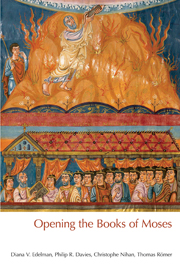1 - The Present State of Pentateuchal Research and the Task of This Volume
Summary
The Pentateuch, or Torah, has been a distinct component of the Jewish Scriptures since at least the second century BCE. Until the advent of critical scholarship it was traditionally accepted by both Jews and Christians as written by Moses. Problems with Mosaic authorship were noted already in the Middle Ages, when Isaac ben Jesus and Ibn Ezra compiled a list of ‘post Mosaica’ verses that Moses could never have written, though they dared not openly challenge entrenched belief in the Mosaic authorship of most of the text. In the seventeenth century we find a more systematic questioning of this notion, especially by Spinoza (1632–77) and Hobbes (1588–1679), but only with the advent of source-criticism was the integrity of the ‘Five Books of Moses’ as a literary corpus challenged.
By the beginning of the nineteenth century, the ‘Documentary Hypothesis’ as elaborated by A. Kuenen and J. Wellhausen became the standard model to explain the formation of the Pentateuch, or even more, the Hexateuch (Genesis–Joshua). The book of Joshua was considered to be the original conclusion to the books of the Pentateuch since it narrated the near-fulfillment of the land-promise, a major pentateuchal theme. The ‘Documentary Hypothesis’ postulates that there are four major ‘sources’ or ‘documents’, the Yahwistic source, the Elohistic source, the book of Deuteronomy, and the Priestly document, which, except for Deuteronomy, narrate a coherent story running from the Patriarchs at least to the conquest of the land.
- Type
- Chapter
- Information
- Opening the Books of Moses , pp. 1 - 10Publisher: Acumen PublishingPrint publication year: 2012

